Indulge in delightful and health-conscious gluten-free treats with Tastepan’s collection of convenient baking mixes. We understand the importance of prioritizing your well-being, which is why we have carefully curated a range of nutritious and delicious options. Whether you’re on a gluten-free diet or simply looking to explore new flavors, our baking mixes are designed to cater to your dietary needs without compromising on taste. From cakes to cookies, breads, and more, discover the art of gluten-free baking and nourish your body while savoring every bite.

The Basics of Gluten-Free Baking
Understanding Gluten
Gluten is a protein that is found in wheat, barley, and rye. It is responsible for giving dough its elasticity and allowing it to rise. However, for those with gluten intolerance or celiac disease, consuming gluten can cause a range of health issues.
The Need for Gluten-Free Baking
Gluten-free baking is essential for individuals who have celiac disease or gluten sensitivity. These conditions require a strict gluten-free diet to avoid discomfort and other health complications. Gluten-free baking allows individuals to enjoy a wide variety of baked goods while still adhering to their dietary restrictions.
Challenges of Gluten-Free Baking
Baking without gluten presents several challenges. Without gluten, it can be difficult to achieve the same texture and structure in baked goods. Gluten helps to bind ingredients together and provides elasticity. Without it, baked goods can become crumbly and dry. However, with the right techniques and ingredients, these challenges can be overcome.
Advantages of Gluten-Free Baking Mixes
Convenience
One of the biggest advantages of using gluten-free baking mixes is the convenience they offer. These mixes typically come pre-mixed and measured, saving you time and effort in sourcing and measuring individual gluten-free flours. With a baking mix, you can easily whip up a batch of cookies or a loaf of bread without the hassle of measuring multiple ingredients.
Consistency
Gluten-free baking mixes are carefully formulated to provide consistent results. They have already been tested and perfected, ensuring that you achieve the desired texture and taste in your baked goods. This consistency can be difficult to achieve when working with gluten-free flours individually, making baking mixes a reliable option.
Versatility
Another advantage of gluten-free baking mixes is their versatility. Many mixes can be used to make a variety of baked goods, from bread and pastries to cookies and cakes. This versatility allows you to experiment with different recipes and explore various flavors and textures.

Different Types of Gluten-Free Baking Mixes
All-Purpose Gluten-Free Baking Mixes
All-purpose gluten-free baking mixes are incredibly versatile. They can be used as a substitute for regular all-purpose flour in a wide range of recipes. These mixes usually contain a blend of gluten-free flours, starches, and leavening agents, providing the necessary structure and texture for baking.
Bread and Pastry Gluten-Free Baking Mixes
Bread and pastry gluten-free baking mixes are specifically formulated to mimic the texture and taste of traditional bread and pastries. These mixes often contain additional ingredients like xanthan gum or psyllium husk, which help provide a better rise and chewiness to the final product.
Cake and Cookie Gluten-Free Baking Mixes
Cake and cookie gluten-free baking mixes are designed to give you the perfect texture and taste for these specific baked goods. These mixes often contain ingredients like tapioca starch or almond meal to achieve a light and fluffy texture in cakes and a soft and chewy texture in cookies.
Popular Brands of Gluten-Free Baking Mixes
Bob’s Red Mill
Bob’s Red Mill is a well-known brand that offers a wide variety of gluten-free baking mixes. They prioritize quality and taste in their products and have options for different types of baked goods. Whether you’re craving cookies, cakes, or bread, Bob’s Red Mill has a mix for you.
Pamela’s Products
Pamela’s Products is another popular brand that specializes in gluten-free baking mixes. They are known for their wide range of options and high-quality ingredients. From flour blends to pancake mixes, Pamela’s Products has something to suit every baking need.
King Arthur Flour Company
King Arthur Flour Company is a trusted name in the baking industry, and they also offer a selection of gluten-free baking mixes. Their mixes are made with high-quality ingredients and are formulated to provide excellent taste and texture in all your gluten-free creations.

Tips for Using Gluten-Free Baking Mixes
Read Instructions Carefully
When using gluten-free baking mixes, it’s crucial to read the instructions carefully. Different mixes may require different ratios of liquids or additional ingredients. Following the instructions precisely will help ensure the best results.
Measure Accurately
Accurate measuring is essential when working with gluten-free baking mixes. Use measuring cups and spoons specifically designed for dry ingredients to get precise measurements. This attention to detail can make a significant difference in the final outcome of your baked goods.
Experiment with Flavors and Additions
Gluten-free baking mixes provide a solid foundation, but don’t be afraid to experiment with flavors and additions. Add your favorite spices, fruits, or nuts to personalize your baked goods and enhance their taste. Get creative and have fun with your gluten-free baking!
Substitutions for Common Ingredients
Flour Substitutions
If you don’t have a gluten-free baking mix on hand, you can create your own by substituting regular all-purpose flour with gluten-free flour blends. Popular options include rice flour, almond flour, and tapioca flour. Experiment with different combinations to find your preferred texture and taste.
Egg Substitutions
Eggs play an important role in baking by providing structure and moisture. If you need to avoid eggs, there are several egg substitutes available. Common alternatives include mashed bananas, applesauce, flaxseed meal, or commercial egg replacers. These substitutes can help bind the ingredients together and provide moisture.
Dairy Substitutions
If you’re following a gluten-free and dairy-free diet, there are plenty of dairy substitutions available for baking. Replace milk with non-dairy alternatives like almond milk, coconut milk, or oat milk. For butter, coconut oil or dairy-free margarine can be used. These substitutions allow you to enjoy delicious, dairy-free baked goods.
Exploring Gluten-Free Baking Mix Alternatives
Making Your Own Gluten-Free Baking Mixes
If you prefer a more hands-on approach, you can make your own gluten-free baking mixes at home. There are numerous recipes available that allow you to create customized blends of gluten-free flours and starches. Making your own mix gives you full control over the ingredients and allows for experimentation with different flavors.
Using Alternative Ingredients
Gluten-free baking doesn’t have to be limited to only gluten-free flours. Many alternative ingredients can add flavor, texture, and nutrients to your baked goods. Try incorporating ingredients like nut flours, coconut flour, or ground seeds into your recipes for a unique twist. These alternative ingredients can provide a boost of flavor and nutritional value.
Recipes and Ideas Using Gluten-Free Baking Mixes
Classic Chocolate Chip Cookies
Ingredients:
- 2 cups gluten-free baking mix
- 1/2 cup butter or dairy-free margarine
- 1/2 cup brown sugar
- 1/4 cup granulated sugar
- 2 teaspoons vanilla extract
- 1 egg or egg substitute
- 1 cup chocolate chips
Instructions:
- Preheat the oven to 350°F (175°C) and line a baking sheet with parchment paper.
- In a large bowl, cream together the butter, brown sugar, and granulated sugar until light and fluffy.
- Add the egg or egg substitute and vanilla extract, and mix well.
- Gradually add the gluten-free baking mix and mix until well combined.
- Stir in the chocolate chips.
- Drop rounded tablespoons of dough onto the prepared baking sheet and flatten slightly.
- Bake for 10-12 minutes, or until golden brown around the edges.
- Allow the cookies to cool on the baking sheet for a few minutes before transferring them to a wire rack to cool completely.
Homemade Sandwich Bread
Ingredients:
- 3 cups gluten-free bread baking mix
- 1 1/4 cups warm water
- 2 tablespoons oil
- 2 teaspoons active dry yeast
- 1 tablespoon honey or maple syrup (optional)
- 1 teaspoon salt (optional)
Instructions:
- In a small bowl, combine the warm water, yeast, and honey or maple syrup. Let it sit for 5 minutes, or until foamy.
- In a large bowl, combine the gluten-free bread baking mix and salt (if using).
- Add the yeast mixture and oil to the dry ingredients and mix well to form a dough.
- Transfer the dough to a greased loaf pan.
- Cover the loaf pan with a clean kitchen towel and let the dough rise in a warm place for about 1 hour, or until doubled in size.
- Preheat the oven to 375°F (190°C).
- Bake the bread for 30-35 minutes, or until golden brown on top and cooked through.
- Remove the bread from the oven and let it cool in the pan for a few minutes before transferring it to a wire rack to cool completely.
Blueberry Muffins
Ingredients:
- 2 cups gluten-free baking mix
- 1/2 cup granulated sugar
- 1/2 teaspoon baking powder
- 1/2 teaspoon baking soda
- 1/4 teaspoon salt
- 1 cup unsweetened applesauce
- 1/4 cup oil
- 1 teaspoon vanilla extract
- 1 cup fresh or frozen blueberries
Instructions:
- Preheat the oven to 375°F (190°C) and line a muffin tin with paper liners.
- In a large bowl, combine the gluten-free baking mix, sugar, baking powder, baking soda, and salt.
- In a separate bowl, whisk together the applesauce, oil, and vanilla extract.
- Gradually add the wet ingredients to the dry ingredients and stir until just combined.
- Gently fold in the blueberries.
- Divide the batter evenly among the muffin cups, filling each about 2/3 full.
- Bake for 15-18 minutes, or until a toothpick inserted into the center of a muffin comes out clean.
- Allow the muffins to cool in the tin for a few minutes before transferring them to a wire rack to cool completely.
Gluten-Free Baking for Special Dietary Needs
Vegan-Friendly Options
For those following a vegan diet, gluten-free baking can still be enjoyed. Simply choose vegan-friendly gluten-free baking mixes and substitute any animal-based ingredients with plant-based alternatives. Use dairy-free milk, vegan butter or oil, and egg substitutes like flaxseed meal or applesauce to create tasty vegan gluten-free treats.
Paleo-Friendly Options
If you’re following a paleo diet, you can still enjoy gluten-free baked goods by opting for paleo-friendly baking mixes. These mixes are made with ingredients that mimic those consumed during the Paleolithic era. Look for mixes that are free from grains, dairy, and refined sugars to accommodate your dietary preferences.
Low-Sugar or Sugar-Free Options
For those watching their sugar intake, there are gluten-free baking mixes available that are low in sugar or completely sugar-free. These mixes use alternative sweeteners like stevia or monk fruit extract to achieve the desired sweetness. You can also experiment with reducing the amount of sugar in a recipe by substituting it with a natural sweetener like mashed bananas or unsweetened applesauce.
Expert Advice on Gluten-Free Baking
Baking Techniques and Tips
When it comes to gluten-free baking, there are specific techniques and tips to keep in mind for optimal results. It’s important to mix the ingredients well to ensure they are fully incorporated and to achieve the desired texture. Additionally, using xanthan gum or psyllium husk can help improve the structure and elasticity of gluten-free baked goods.
Storage and Shelf Life of Baking Mixes
Most gluten-free baking mixes have a relatively long shelf life if stored correctly. It’s important to store them in a cool, dry place away from moisture and direct sunlight. Always check the expiration date on the packaging to ensure the mix is still fresh before using it. Once the mix is opened, reseal it tightly to maintain its freshness.
Troubleshooting Common Issues
If you encounter any issues with your gluten-free baking, don’t worry! There are solutions for common problems. If your baked goods are too dry, try adding a bit more moisture, such as extra oil, applesauce, or yogurt. If the texture is too crumbly, adding xanthan gum or psyllium husk can help bind the ingredients together. Don’t be afraid to experiment and adjust the recipe to achieve the best results.
In conclusion, gluten-free baking offers a world of possibilities for individuals with celiac disease, gluten sensitivity, or those who choose to follow a gluten-free lifestyle. With the wide variety of baking mixes available, gluten-free baking has never been more accessible and delicious. Whether you’re in the mood for cookies, bread, or muffins, there is a gluten-free baking mix that will help you create the perfect treat. So, grab your favorite mix, follow the instructions carefully, and enjoy the art of gluten-free baking!

